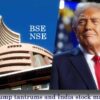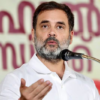India Aims for Early US Trade Deal, Says Finance Minister Nirmala Sitharaman
Finance Minister Nirmala Sitharaman, during the initial leg of her five-day trip to the United States, expressed India’s optimism about concluding the first phase of a trade agreement with the US by autumn. Her remarks highlight the urgency of sealing the deal in a bid to strengthen economic ties between the two nations and avoid potential tariff hikes from the Trump administration.
Sitharaman made the comments while addressing the Indian diaspora in San Francisco, emphasizing that the engagement with the United States is not just about tariff issues but also about securing a comprehensive trade agreement with India’s largest trading partner. “The long and short of engaging with the US is not just for this reciprocal tariff-related matter, but in the interest of… our largest trading partner with whom we need to have an agreement,” she said, indicating the broader scope of the discussions.
During her visit, the Finance Minister will attend several high-profile events, including the spring meetings of the International Monetary Fund (IMF) and the World Bank, as well as the G20 finance ministers and central bank governors meeting. Sitharaman’s trip is part of India’s ongoing efforts to foster closer economic ties with the US, with trade being a key focus.
A major point of contention in the trade relationship between the US and India has been tariffs. The Trump administration had previously imposed high tariffs on Indian goods, and New Delhi has been working to resolve the issue through talks aimed at reducing barriers to trade. Officials in New Delhi are working to avoid steep tariff increases after President Trump announced a 90-day pause on tariff hikes for major trading partners, including India, on April 9.
India’s chief negotiator for the deal, Rajesh Agrawal, is set to visit the US later this week for a three-day trip to engage in further discussions. The hope is that by the end of the 90-day period, India and the US will have reached a mutually beneficial agreement, ensuring continued access to markets without the threat of additional tariffs.
Sitharaman’s visit also coincides with another significant diplomatic event, as US Vice President JD Vance began a four-day visit to India on Monday. Vance’s visit will include talks with Prime Minister Narendra Modi, focusing on strengthening bilateral ties. The two leaders are expected to review progress on the bilateral agenda, which was outlined during Modi’s meeting with President Trump in February. The review is likely to include trade issues, among other points of cooperation.
India has indicated its willingness to make concessions in the trade talks, including reducing tariffs on a wide range of American imports. In return, India hopes to secure a better deal for its own exports to the US. The US is India’s largest trading partner, with the two-way bilateral trade reaching $129 billion in 2024. Of that, India enjoyed a $45.7 billion surplus, underscoring the importance of the trade relationship for both countries.
While the specifics of the trade deal are still being worked out, India is open to cutting tariffs on more than half of its imports from the US, which were valued at $41.8 billion in 2024. This offer is seen as a key step in fostering deeper economic ties and promoting a more balanced trade relationship between the two nations.
Sitharaman’s visit and the ongoing negotiations come at a crucial time for India, as the government seeks to boost its trade relationship with the US while simultaneously securing economic benefits for the country’s businesses and consumers. The outcome of these discussions could have long-lasting implications for India’s trade policy and its global economic standing.
In conclusion, the India-US trade talks are gaining momentum, with both countries seeking to address long-standing trade imbalances and tariff issues. The coming months will be critical in determining whether the two sides can successfully conclude the first phase of their trade pact by autumn, setting the stage for deeper cooperation in the future.
IT.
























